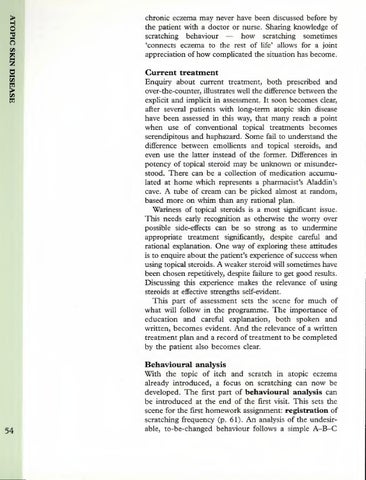> O 2 ~ C/5 5j
.
chronic eczema may never have been discussed before by the patient with a doctor or nurse. Sharing knowledge of scratching behaviour how scratching sometimes 'connects eczema to the rest of life' allows for a joint appreciation of how complicated the situation has become.
Z
0 ÂŁ > ^ tfl
j4
Current treatment Enquiry about current treatment, both prescribed and over-the-counter, illustrates well the difference between the explicit and implicit in assessment. It soon becomes clear, after several patients with long-term atopic skin disease have been assessed in this way, that many reach a point when use of conventional topical treatments becomes serendipitous and haphazard. Some fail to understand the difference between emollients and topical steroids, and even use the latter instead of the former. Differences in potency of topical steroid may be unknown or misunderstood. There can be a collection of medication accumulated at home which represents a pharmacist's Aladdin's cave. A tube of cream can be picked almost at random, based more on whim than any rational plan. Wariness of topical steroids is a most significant issue. This needs early recognition as otherwise the worry over possible side-effects can be so strong as to undermine appropriate treatment significantly, despite careful and rational explanation. One way of exploring these attitudes is to enquire about the patient's experience of success when using topical steroids. A weaker steroid will sometimes have been chosen repetitively, despite failure to get good results. Discussing this experience makes die relevance of using steroids at effective strengths self-evident. This part of assessment sets the scene for much of what will follow in the programme. The importance of education and careful explanation, both spoken and written, becomes evident. And the relevance of a written treatment plan and a record of treatment to be completed by the patient also becomes clear. Behavioural analysis With the topic of itch and scratch in atopic eczema already introduced, a focus on scratching can now be developed. The first part of behavioural analysis can be introduced at the end of the first visit. This sets the scene for the first homework assignment: registration of scratching frequency (p. 61). An analysis of the undesirable, to-be-changed behaviour follows a simple A-B-C
